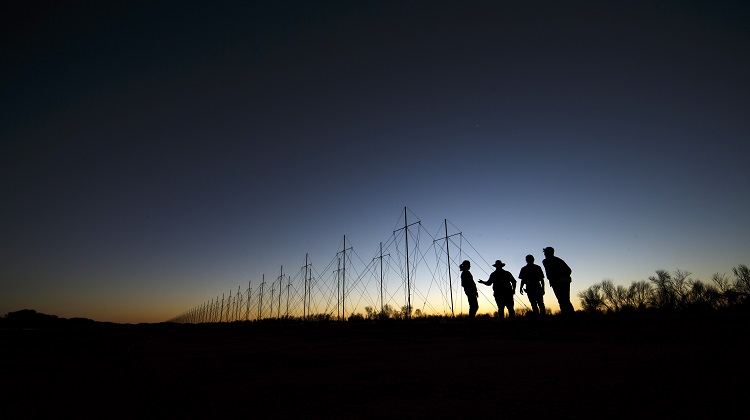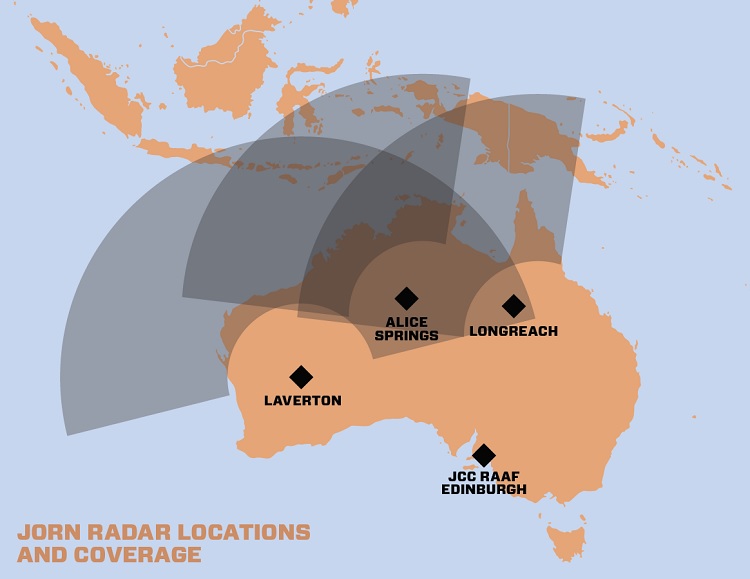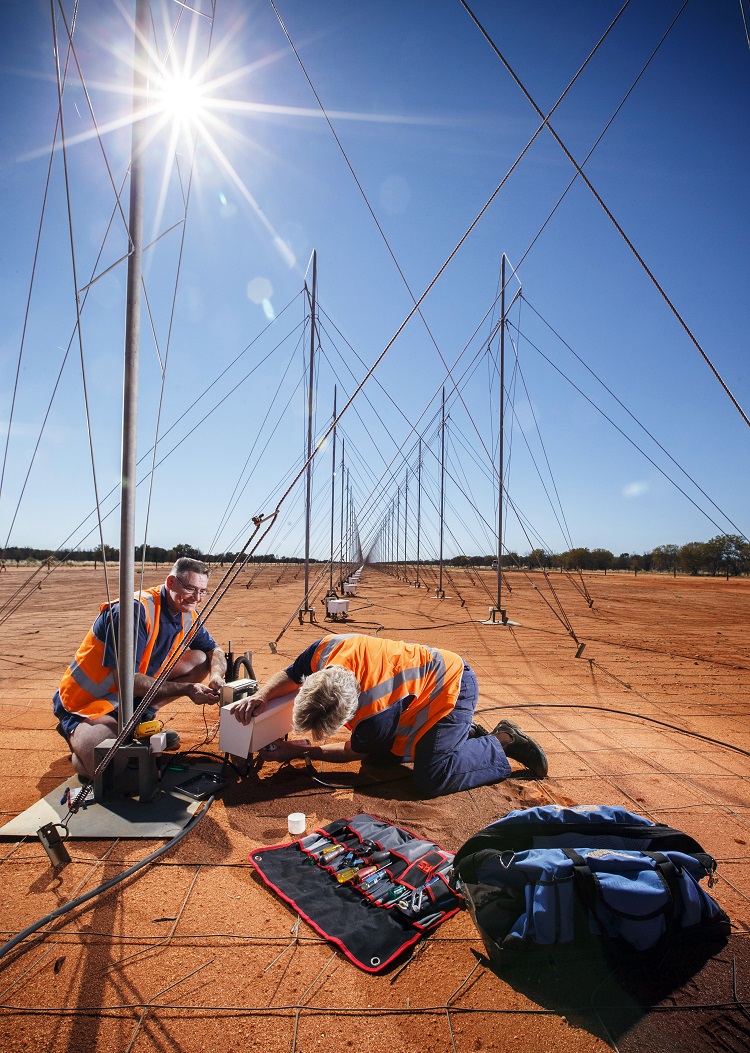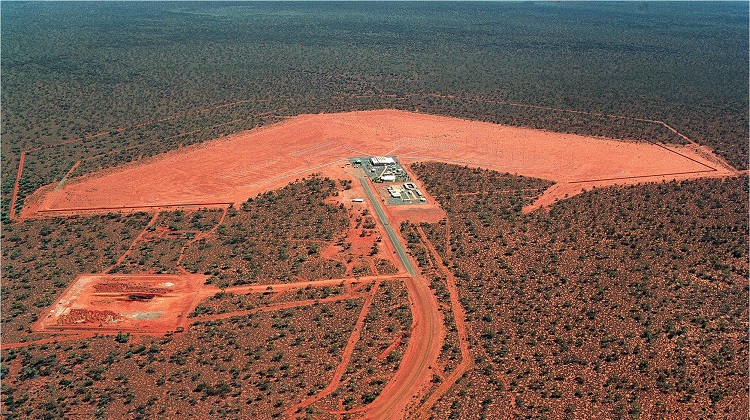Feature - OVER THE HORIZON | ADBR
FEATURE STORY – Australia’s world-leading Jindalee Operational Radar Network (JORN) is undergoing a refresh to keep it at the leading edge
By Max Blenkin

(BAE SYSTEMS)
More than three decades ago, Australia embarked on what was perhaps the most challenging defence project yet – developing a national radar system able to see far out into the Indian ocean and north into the Indonesian Archipelago.
This was the Jindalee operational radar network (JORN), a high-frequency (HF) over-the-horizon radar (OTHR). Officially, JORN is able to detect ships the size of a patrol boat or aircraft the size of a small jet out to 3,000 kilometres. But unofficially, it can do a whole lot better than that.
This is one of Australia’s technological crown jewel, a capability where we lead the world and where we even sell technology to the United States.
But, as good as JORN is, it will get a whole lot better under a $1.2 billion decade-long refresh program now being conducted by BAE Systems Australia.
Steve Wynd, BAE Systems Australia JORN upgrade program director, likens this upgrade to when we moved from the analogue mobile phones of the 1990s and early 2000s, to today’s digital iPhone or Android smart phone technology.
The old analogue mobiles provided perfectly adequate voice communications, but the move to digital brought vastly more capability, as anyone with a smartphone readily appreciates. And so it will be with JORN.
“We are actually changing the software architecture to sit on a data backbone which basically means JORN becomes a series of apps that plug into that data backbone,” Wynd told ADBR.
“The digitisation puts in a whole lot of hardware capability, but the software in Phase 6 exploits it to an extent that there is a lot more capability in JORN beyond that. The app-based approach allows it to go into a spiral upgrade which will make it very simple to upgrade and add mods into the system.”

(ADBR)
Wynd said in the past it had been really difficult to adapt the JORN system quickly as the operational environment changed and the operators wanted to do different things. “We want an agile system that allows us to plug equipment and software in and play very quickly,” he said.
This project – AIR 2025 Phase 6 – is not without risk and is a very significant undertaking. The underlying technology and software are uniquely Australian, and we are in it on our own – there is no foreign partner to carry most of the risk.
However, the JORN Priority Industry Capability (PIC) Support Program performed by BAE Systems and Lockheed Martin in conjunction the Defence Science and Technology group (DST) and Defence Capability Acquisition and Sustainment Group (CASG) significantly reduced this technical risk prior to contract award.
The 2016 Defence Integrated Investment Plan (IIP) cites a project cost of $1-2 billion over the period 2017-26, and describes Phase 6 thus:
“The Jindalee operational radar network will be enhanced through a spiral development program into the 2030s in order to realise its full potential as a wide area surveillance capability.
“Enhanced command, control, communications, computers and intelligence integration will allow Jindalee to cue and be cued by other systems across the sensor network.
“The core role of these systems is the defence of Australia and its surrounding airspace by identifying aircraft and some surface vessels approaching Australia.”
Of all Australia’s significant defence assets, JORN is perhaps the least visible to the vast majority of Australians, and the least appreciated for what it delivers.
Sydney residents can at least see ships and submarines in the harbour and the occasional F/A-18 or C-17 flying overhead. But JORN is way out in the sticks, its facilities invisible to all but the locals and the passing wildlife.
JORN features three vast transmitter and receiver antenna arrays at Longreach in Queensland, Laverton in Western Australia, and Alice Springs in the Northern Territory, and the command centre is located at RAAF Edinburgh near Adelaide.
There are another dozen ionosondes across the country – special radars whose purpose is to constantly map the state of the ionosphere, that layer of the atmosphere on which JORN relies to refract signals out beyond the horizon and back.
JORN had its origin in research conducted after World War 2. But first a bit about the electromagnetic spectrum – which features gamma ray radiation at one end, visible light around the middle and radio waves at the other end.
The radio frequency spectrum is further divided into bands and, for our purposes, the HF band covers 3-30 MHz (megahertz – million cycles per second) with wavelengths 100-10 metres. That’s slightly further up the spectrum than the AM radio broadcast band. The higher the frequency, the shorter the wavelength.
Radar developed in the 1930s operated in the High Frequency (HF) band, and this still immature capability worked well enough to help the RAF win the Battle of Britain.
But as WW2 progressed, technological development produced radars which operated at much higher frequencies (shorter wavelengths), with many advantages in improved performance and smaller size, allowing units to be fitted in aircraft.
HF radio would be not much more than an interesting technological relic were it not for a particular feature. HF radio signals bounce off the ionosphere, which makes them useful for long distance communication, independent of satellites – Australian warships use HF as well as satellite comms – as well as for OTHR.
HF radar is actually making something of a comeback as, theoretically at least, it can ‘see’ otherwise low-observable aircraft because modern ‘stealthy’ aircraft such as the F-35 are designed to be least visible to conventional fire control radars which operate at much higher frequencies.
So can JORN spot aircraft such as an F-35? Reportedly it can, although that’s never been officially confirmed and likely never will be.
After WW2, the US Naval Research Laboratory conducted some OTHR research, to which Australian scientists later gained access. In his excellent history of OTHR development in Australia, Dr Don Sinnott noted that by the early 1950s the then Electronics Research Division of the Department of Supply and Development’s Long-Range Weapons Base Establishment at Salisbury, South Australia was conducting research aimed at determining ionospheric stability “with an eye to OTHR”.
For Australia, the prospect of a long-range radar system was especially alluring. After all, Japanese aircraft and ships had attacked the Australian mainland and, as the Cold War deepened, who knew what else could be coming our way.
Australia is scarcely alone in seeing the benefits of OTHR, and plenty of others have worked on or continue to work on the technology. For example, the UK/US Cobra Mist system operated from England during the Cold War to detect aircraft movements over the western USSR.

The JORN transmitter site at Harts Range, Alice Springs. (DEFENCE)
The US Air Force operated east and west-facing OTHR from the US during the Cold War, and the US Navy still operates three south-facing OTHRs to detect drug smuggling ships and aircraft coming from South America.
The USSR/Russia has long maintained an interest in OTHR dating back to the start of the Cold War. This was hardly a secret, as the Russian radar – referred to as the ‘Russian woodpecker’ – broadcast loudly in the international shortwave radio band. France, China and Iran also have OTHR systems.
OTHR would be a whole lot easier for everyone if the ionosphere remained stable, but it doesn’t. The ionosphere is that layer of the atmosphere 75-1,000 kilometres above the earth, charged (ionised) by solar and cosmic radiation. It’s this ionisation which makes it reflective of radio frequencies in the HF band.
The ionosphere varies constantly and requires monitoring so the JORN signal can be optimised to achieve the best results. It varies between day and night – at night, the system requires frequencies lower in the band.
Australian research into HF radar IN the 1960s made some useful discoveries. One was that a rocket departing the atmosphere produced a very large and easily detected bloom in the OTHR return signal.
This had very significant implications for ICBM launch detection, and the US was most interested. In various technical talks in the 1960s, the US confirmed their own OTHR experiments which managed to detect distant aircraft – confirming to the Australian researchers they were on the right track.
In October 1969 a mission of Australian specialist researchers talked OTHR in the US, and formalised arrangements for cooperation. Significantly, this convinced the Australian Defence Department to initiate serious work on OTHR.
Phase 1 was approved in November 1970 and was designated Geebung. The name Jindalee – an indigenous word for bare bones – was apparently first applied in 1972, a reflection of the lean project which researchers were undertaking.
There are suburbs called Jindalee in Brisbane and Perth, where the name is said to mean bare hills, while the vast JORN antenna arrays stretching across the red dirt landscape are vaguely reminiscent of the skeleton of some enormous ancient reptile.
To demonstrate feasibility, an experimental OTHR was constructed outside Alice Springs and that led to the larger Stage B radar. A decision to proceed with creation of the complete network was announced in 1986.
The 1987 Defence White Paper articulated the vision:
“With an OTHR we expect to be able to monitor the great expanses of our sea and air approaches and provide long-range detection and tracking of aircraft and surface ships. Without an OTHR network we would remain essentially unaware of movements of interest in our vast maritime approaches.”

(BAE SYSTEMS)
So who was to perform this complex work? It was to be none other than the national telco Telstra which signed the $800 million contract in June 1991. Telstra was to be the prime contractor, with a range of other contractors including GEC Marconi and Telstar Systems, a joint venture between Telstra and Lockheed Martin.
JORN was to be up and running in June 1997, but with Telstra having no experience with major defence projects, let alone one of this magnitude and technical complexity, the scathing news stories weren’t long in appearing. JORN became an early poster child for problematic procurement projects.
The Australian National Audit Office (ANAO) reported in June 1996, and the issues it identified seem depressingly familiar. It said many of the difficulties and slippages could have been avoided if Defence had appointed an experienced project management team in the Jindalee Project Office (JPO), ready to deal firmly and proactively with Telstra.
A consequence was that the JPO had paid Telstra 80 per cent of the contract target price but, by May 1996, less than 20 per cent of system-critical designs had been reviewed against the contract’s technical review standards. Telstra subsequently reported a loss of more than $600 million and said it could not guarantee a delivery date.
In hindsight, Telstra certainly appears an unlikely choice for such a major defence project. Although it had no specific experience IN HF radar, it did have a research arm and was unquestionably all-Australian and more likely to achieve the government’s mandated 70 per cent local content.
This was also an era when Defence embarked on a number of highly developmental projects, where confidence exceeded technological and project management capability. We now do this much better.
With Telstra foundering, the JORN contract was taken over by Lockheed Martin and Tenix which formed the joint venture RLM Group. In 2008 Lockheed Martin bought out the Tenix share of RLM.

(BAE SYSTEMS)
From these troubled beginnings, JORN Phases 3 and 4 delivered the operational radars in Queensland and WA in 2003. Phase 5 delivered further enhancements and integration of the Alice Springs radar (termed Radar 3) into a single network, and became fully operational in 2014.
In its current guise, JORN is impressive and may actually far exceed publicly acknowledged capabilities. It may see much further, maybe into the South China Sea and beyond, and likely can see stealth aircraft, an increasingly useful capability with the development of 5th gen aircraft by China in recent years.
But there are limitations. JORN doesn’t see everything all at once – it sequentially examines particular areas, akin to tiles. Though the three-kilometre antenna arrays themselves are fixed, the radar operates as a phased array, with the beam steered by adjusting transmission phase on the different antenna elements.
JORN is also a Doppler radar which detects moving objects according to differences in frequency of the reflected signals. That means it has problems with stationary targets or objects moving in ‘the notch’, ie perpendicular to the arrays. The ionosphere also moves and that can introduce its own errors.
JORN also has problems with small wooden boats, of the type which headed south from Indonesia in large numbers at the height of the asylum seeker influx. That’s because of the boats’ small size and wooden construction, which makes them a poor reflector of radio waves.
But that’s not just a problem for JORN, as conventional radar is also troubled by small vessels of non-metallic construction, which is why yachts routinely carry radar reflectors on their masts to ensure they are visible to larger vessels or to search and rescue aircraft.
From the earliest days of OTHR it was appreciated that effective processing of the return signals was fundamental to getting the best results, and that required computer capabilities which just weren’t available for most of JORN’s development. It’s certainly a tribute to the pioneering engineers who proved it a viable concept with such limited computing capabilities.
Computers in the 1990s when JORN’s architecture was designed had come a long way from the 1970s, but by current standards are still dated. And that brings us to JORN Phase 6.
Last year BAE Systems Australia won the Phase 6 contract over Lockheed Martin Australia – ending LM’s long involvement with JORN. Phase 6 will see the 1990s receiver units replaced, and software and dated architecture replaced with a contemporary digital system with open architecture.
On the hardware side, the existing antenna arrays will remain, along with the feed cables and the high-powered amplifiers on the transmit antennae. Upgrading of these amplifiers – each of which produce more than 20 kilowatts of power – isn’t included in Phase 6, but will come later, but the power amplifier drive train will be upgraded and digitised.
On the receive side, the receiver modules will be replaced, producing a digital rather than analogue output and feeding into all-new digital processing systems.
Wynd says upgrading of hardware such as the receivers poses one of their biggest risks of the project. The plan is to upgrade the receiver chain on the Longreach radar, followed by Laverton.
“The performance of that receiver is extremely important to the outcome of JORN,” he said. “What makes JORN so good is the sensitivity of the instrument. That has gone through a couple of different prototypes and we are pretty close to saying we understand the risk and the hardware should work.
“We worked pretty closely with DST,” he added. “They had some ideas and some reference designs through their research, and the engineering on that has worked quite well.”
“The other risk area we have is around the digital driver. What we are developing under Phase 6 is a direct digital drive chain so that the low-power analogue signal gets generated out of a digital waveform. What that allows us to do is quickly change or adapt waveforms and put new waveforms into the system.”
Across JORN, this is a lot of new hardware. Each array features 480 antenna pairs and, across the system that will require 2,500 new receivers. The upgrade requires 12 new boxes to be designed from scratch. From the receiving antennae, the weak analogue return signal goes to nearby bunkers where it is converted to a digital signal which then goes further into the system for further processing.
There is substantial software development required, but not the key system algorithms which have already been developed and supplied by DST.
Much of the difficulty in initially getting JORN up and running in the first place related to software development, with the contractor Telstra carrying that development risk. That doesn’t apply this time, although it’s still a complex undertaking. Wynd said the old system, programmed in Ada, had been likened to an old telephone exchange with wires running everywhere.
“That’s how the software talks at the moment,” Wynd said. “With the app-based approach, you just plug an app into the operating system and that looks after how you move data around the system.
“We are building the software in five releases for the first radar upgrade,” he added. “As we write new software, we pull out the old bit and plug in the new bit. What that means is you are reducing a lot of the integration risk. The intention is to change a bit at a time and have a system that keeps working.”

In order to achieve the best results, real-time knowledge of the ionosphere is essential and that’s provided by a network of oblique and vertical sounding radars called ionosondes. This produces a complete map of the ionosphere over Australia and out into the Indian Ocean every four minutes or so.
JORN’s product is displayed on computer scientific research displays, but it isn’t presented as nice clear images in which targets are clearly discernible. Rather, it’s like looking at a noisy grey picture. Research is also underway on how to improve data presentation and operator performance.
“When we upgrade JORN, we are going to end up putting a lot more data in front of the operators because we can cover more area,” Wynd said. “We want to change the role of the operator so they are looking and acting on recommendations and information rather than trying to trawl through the data and find things. If we don’t, the operators will be overwhelmed by the data.”
Researchers spent a fortnight with the operators, interviewing and even instrumenting them to track eye movements.
“All that will feed back into a new design for how we represent the data to the operator, how we lay out the screens to make them more efficient,” he said. “If we are going to invest effort, how do invest the effort that actually gets the operator to a good decision quicker and reduce the load.”
Wynd said all that highlighted the importance of the JORN frequency management system, a complex process of optimising frequencies according to the state of the ionosphere, the time of day or night and the intended area of surveillance. “We will get a lot better data out of the system with the upgrade.”
The decades of research which produced JORN, plus the experience gained by its operation, have given Australia a technological edge which Wynd says puts Australia years ahead of other OTHR operators.
A year into the project, BAE Systems Australia already has 450 people working on JORN. Some came across from Lockheed Martin and some work on the exports side but there are plenty of new positions. Wynd says this will deliver a generational change in those who will take JORN forward for the next 20-25 years.
“We have brought in 18 graduates into this area this year, we brought in 15 last year, so that’s 33 graduates and we will keep that running for the next few years,” he said.
“We need to build the workforce that can look after JORN and the spiral development in the future. We want to make the investment in that capability. And when you have a $1 billion program, it actually supports a fair bit of R&D-type investment. We are looking at how we work with the universities and start to leverage some of the technologies.”
BAE Systems is also creating a laboratory with Adelaide University to support research and development. “The intent is that we put unclassified JORN data in there. When people are trying to develop in a research sense, their access to data is a big issue,” Wynd said. “We will put some of this in there to help that and we will look at sponsoring some PhD students.”
Then there’s JORN’s RAAF operators, members of No 1 Remote Sensor Unit (1RSU), originally No 1 Radar Surveillance but renamed in 2015 to reflect an expanded brief which now includes keeping track of objects in orbit. This makes it the ADF’s first space operations unit.

An aerial view of a JORN transmitter site at Laverton, WA. (DEFENCE)
This feature article appeared in the March-April 2019 issue of ADBR.


No comments:
Post a Comment